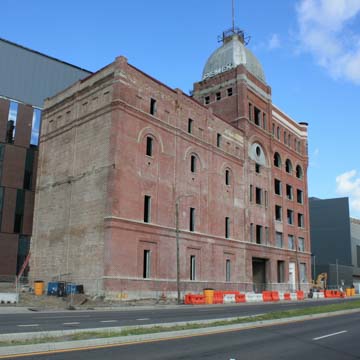With fifty breweries in 1850, New Orleans was known as the “brewing capital of the South.” Prohibition in 1920 officially brought the industry to a close and most of the buildings were later demolished. Some that have survived and found new use are the Jackson (Jax) Brewery in the Vieux Carré, converted into a commercial mall in the 1980s; Weckerling Brewery, which now houses the National World War II Museum (OR122); and the six-story Falstaff Brewery (2600 Gravier Street), closed in 1978 and converted to apartments in 2013 by HMS Architects. Dixie Brewery, designed by a Chicago firm for Valentine Merz, the company’s president, occupied a six-story, steel-framed building of red brick trimmed with white stone. A diminutive corner turret and a tall, silver-painted mansard dome made it an area landmark. Two cylindrical storage tanks on the roof held the rice used in the brewing process, and both tanks were painted to resemble Dixie beer cans. Apart from the giant cans, Dixie had an institutional rather than an industrial appearance and it fit in well with Tulane Avenue’s other buildings. During Prohibition, the brewery manufactured ice and ice cream. Emile Weil designed a four-story extension in 1919. The building was flooded following Hurricane Katrina. Subsequently, the brewery became part of the massive post-Katrina medical center redevelopment project (see OR89) and renovated as a research center.
You are here
Veterans Affairs Medical Center Research Center (Dixie Brewery)
1907, Louis Lehle and Sons, with Julius Koch; 2017 renovated, Eskew+Dumez+Ripple. 2401 Tulane Ave.
If SAH Archipedia has been useful to you, please consider supporting it.
SAH Archipedia tells the story of the United States through its buildings, landscapes, and cities. This freely available resource empowers the public with authoritative knowledge that deepens their understanding and appreciation of the built environment. But the Society of Architectural Historians, which created SAH Archipedia with University of Virginia Press, needs your support to maintain the high-caliber research, writing, photography, cartography, editing, design, and programming that make SAH Archipedia a trusted online resource available to all who value the history of place, heritage tourism, and learning.















